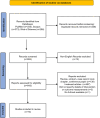Patient Adherence for Oral Combination Therapies in Diabetes Management: A Scoping Review
- PMID: 40309616
- PMCID: PMC12040741
- DOI: 10.1002/hsr2.70780
Patient Adherence for Oral Combination Therapies in Diabetes Management: A Scoping Review
Abstract
Background and aims: Diabetes imposes a global healthcare burden, with Type 2 Diabetes Mellitus (T2DM) escalating due to demographic shifts and lifestyle changes. Combination therapies offer promise in managing T2DM, yet patient adherence remains a challenge. This scoping review aims to explore patient adherence to combination therapies in T2DM management.
Materials and methods: This scoping review followed the Preferred Reporting Items for Systematic reviews and Meta-Analyses extension for Scoping Reviews guidelines. Electronic databases including PubMed, Scopus, and Web of Science were searched until July 10, 2024. Studies focused on patients with T2DM prescribed oral combination therapies were included. Data extraction and synthesis were conducted to identify adherence patterns, influencers, and strategies.
Results: The review identified nine eligible studies spanning from 2004 to 2021, primarily retrospective cohort and cross-sectional designs. Adherence assessment methods varied, with medication possession ratio being the most common. Both dual (loose-dose) and fixed-dose combination therapies were explored. Adherence rates varied across studies and therapies, influenced by factors such as glycemic control, weight management, economic considerations, complexity of regimens, and demographic factors. Bibliometric analysis revealed diverse geographic origins of the included studies and varied adherence assessment methods. Dual therapy regimens demonstrated adherence rates ranging from 49% to 80.8%, while FDC therapies showed adherence rates ranging from 60.3% to 98.9%. Factors influencing adherence included glycemic control, weight management, economic considerations, complexity of regimens, and demographic factors.
Conclusion: Patient adherence to oral combination therapies in diabetes management is complex, affected by clinical, economic, and psychosocial factors. Addressing these issues is crucial for enhancing treatment outcomes and alleviating the burden of diabetes. A patient-centered approach and innovative strategies can empower patients to adhere to medication regimens, improving health outcomes and quality of life.
Keywords: Type 2 Diabetes Mellitus; combination therapy; fixed‐dose combination; medication adherence; oral antihyperglycemic agents.
© 2025 The Author(s). Health Science Reports published by Wiley Periodicals LLC.
Conflict of interest statement
The authors declare no conflicts of interest.
Figures
Similar articles
-
A retrospective study of persistence, adherence, and health economic outcomes of fixed-dose combination vs. loose-dose combination of oral anti-diabetes drugs.J Med Econ. 2016;19(3):203-12. doi: 10.3111/13696998.2015.1109518. Epub 2015 Nov 30. J Med Econ. 2016. PMID: 26473990
-
Impact of adherence and weight loss on glycemic control in patients with type 2 diabetes: cohort analyses of integrated medical record, pharmacy claims, and patient-reported data.J Manag Care Spec Pharm. 2014 Jul;20(7):691-700. doi: 10.18553/jmcp.2014.20.7.691. J Manag Care Spec Pharm. 2014. PMID: 24967522 Free PMC article.
-
Medication adherence with fixed-dose versus free-equivalent combination therapies: Systematic review and meta-analysis.Front Pharmacol. 2023 Mar 22;14:1156081. doi: 10.3389/fphar.2023.1156081. eCollection 2023. Front Pharmacol. 2023. PMID: 37033611 Free PMC article.
-
Medication Management Initiatives Using Wearable Devices: Scoping Review.JMIR Hum Factors. 2024 Nov 27;11:e57652. doi: 10.2196/57652. JMIR Hum Factors. 2024. PMID: 39602520 Free PMC article.
-
Meta-analysis of studies examining medication adherence, persistence, and discontinuation of oral antihyperglycemic agents in type 2 diabetes.Curr Med Res Opin. 2015;31(7):1283-96. doi: 10.1185/03007995.2015.1053048. Epub 2015 Jun 18. Curr Med Res Opin. 2015. PMID: 26023805
Cited by
-
Targeting the molecular crosstalk between diabetes and lung cancer for therapeutic intervention.Discov Oncol. 2025 Jul 28;16(1):1427. doi: 10.1007/s12672-025-03264-x. Discov Oncol. 2025. PMID: 40719815 Free PMC article. Review.
-
Unlocking the dual healing powers of plant-based metallic nanoparticles: managing diabetes and tackling male infertility challenges.Front Endocrinol (Lausanne). 2025 Jul 4;16:1482127. doi: 10.3389/fendo.2025.1482127. eCollection 2025. Front Endocrinol (Lausanne). 2025. PMID: 40687580 Free PMC article. Review.
References
-
- Chan J. C. N., Lim L.‐L., Wareham N. J., et al., “The Lancet Commission on Diabetes: Using Data to Transform Diabetes Care and Patient Lives,” Lancet 396 (2020b): 2019–2082. - PubMed
Publication types
LinkOut - more resources
Full Text Sources




